Lately, we've been loving pineapple water. It's such an easy, refreshing way to stay hydrated. I started making it at home when I wanted something flavorful that wasn’t overly sweet like juice, but still felt like a treat. If you’re trying to drink more water or just need a little tropical pick-me-up (forget the seltzers!), this is our simple, go-to natural fruit-infused water that's gentler on your body. I’ll walk you through how I make it; it’s quick, budget-friendly, and so satisfying!
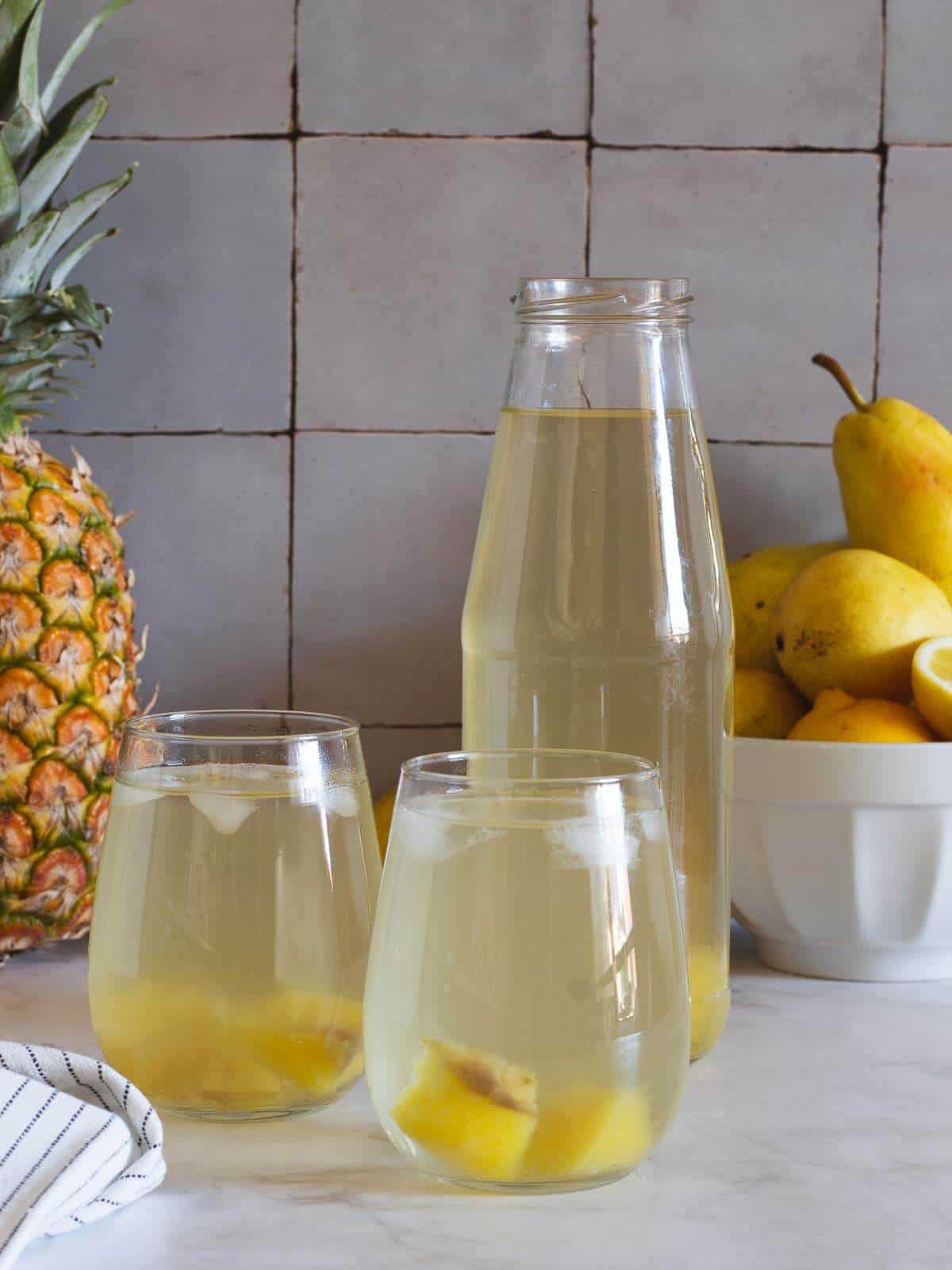
Drinking pineapple water is a delicious way to enjoy a virtually zero-calorie hydrating drink, as it is plain water and can be enjoyed with your meals instead of soda, or drink it during detox days, as it promotes healthy digestion.
This typical Panamanian drink consists of fresh pineapple water. It doesn't get simpler than this recipe. We call it agua de piña (also called agua fresca in Mexico); it has great cleansing properties and Vitamin C.
With the same technique but adding rice to the mix, we make a delicious arroz con piña, a chilled creamy pineapple, and a rice milk smoothie.
A great way to reduce waste and get the richest flavors from fresh produce is creating dishes and drinks that use every bit we can like this pineapple water, pesto sauce with carrots tops, and even watermelon rind gazpacho !
If this topic interests you, check out our post on how to make the best of your meal leftovers.
Read on: recipes with almond pulp leftovers from making almond milk »
Jump to:
🧾 Ingredients
Making pineapple water requires only two ingredients
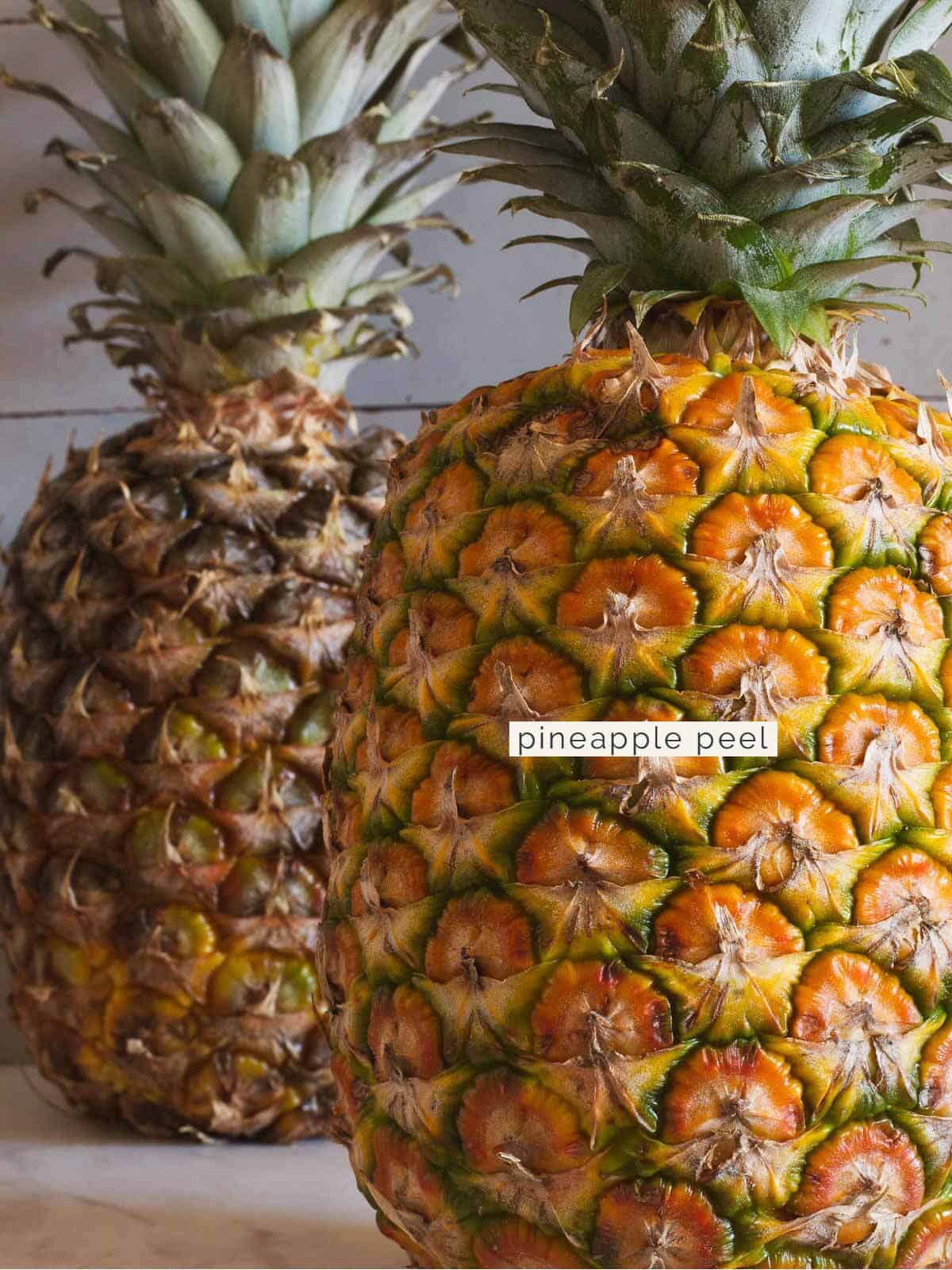
- Ripe pineapple peel (from the whole fruit) - to imbue the water with pineapple flavor
- Fresh water - the less water, the more pineapple flavor.
Optional extra flavorings (not necessary):
Fresh ginger, star anise, cinnamon stick, cloves, or lemon.
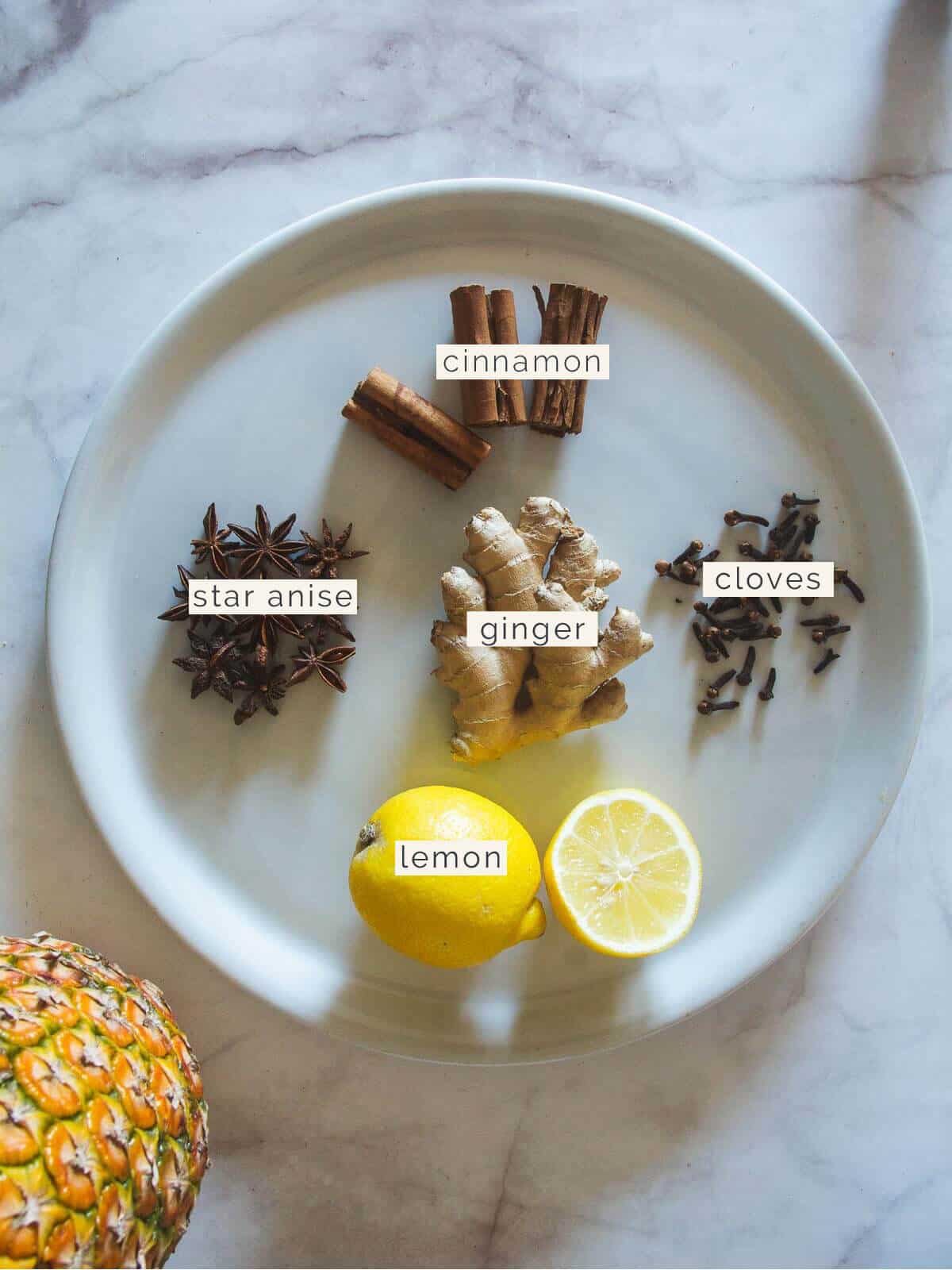
🔪 How to make pineapple water for weight loss
Peel pineapple
To make this pineapple skin water recipe, peel the whole pineapple and reserve the flesh to eat on its own, or freeze the pineapple chunks for a pineapple coconut smoothie, or a strawberry pineapple smoothie.
If you plan to drink your pineapple water on its own, without any other flavoring or sweetener, leave a little bit of flesh on the rinds so the pineapple taste is more concentrated.
Otherwise, you can simply pick one or two small frozen or fresh pineapple chunks to add to the pineapple-infused water.
Tip: you can reserve the rind frozen in a plastic bag or plastic wrap in the freezer and make your pineapple water later.

Check out how to make a perfect pineapple and cucumber smoothie for weight loss.
Boil
Put the pineapple rind in a large saucepan and fill it with enough water. I use about a half-gallon (2 liters) for a medium pineapple.
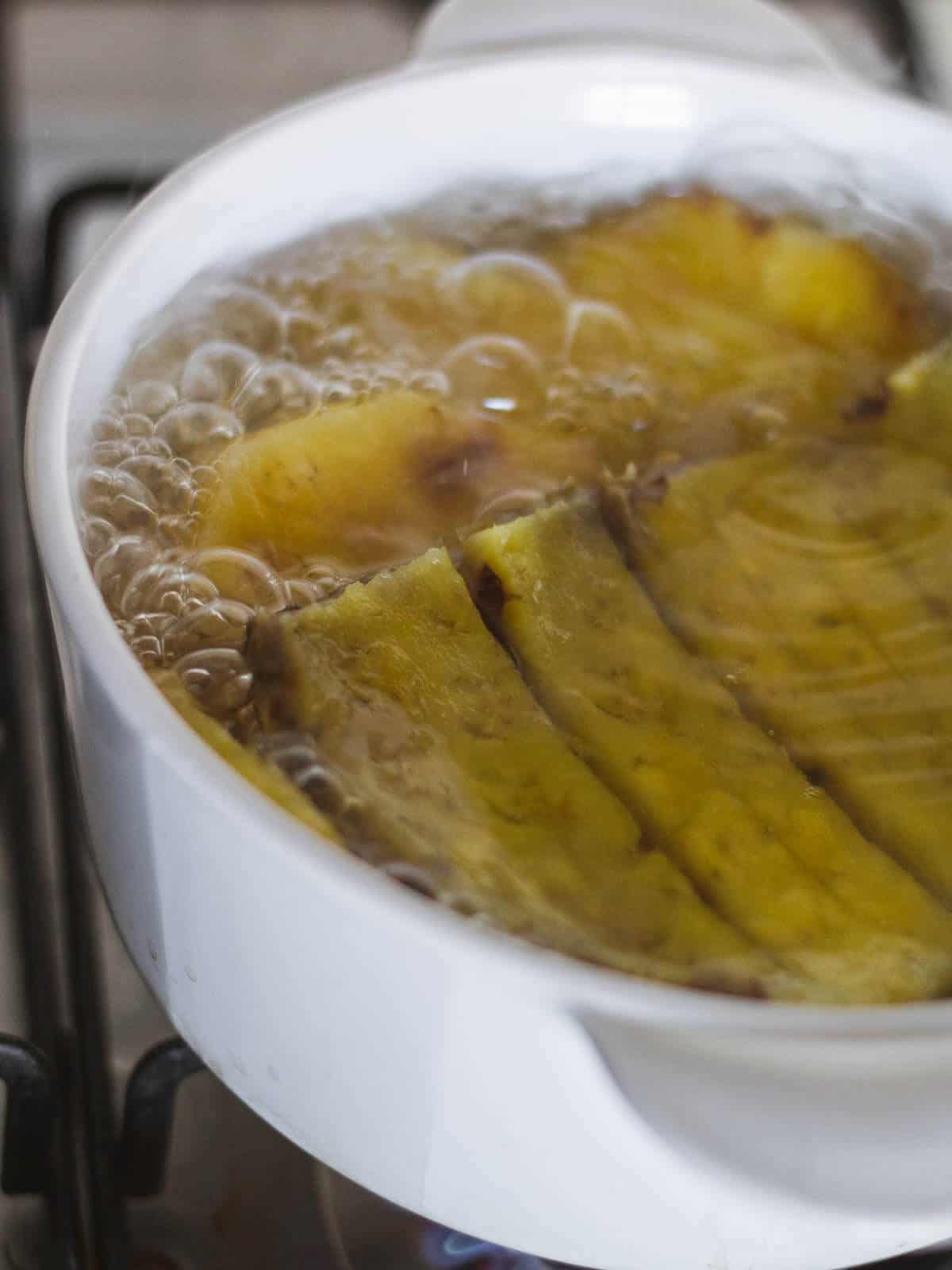
Add any other flavoring you might want to add. I suggest you try pineapple water on its own the first time so you get acquainted with the flavor before trying out any other flavorings.
Bring to a boil for about 15 minutes. Psst! Your kitchen will turn into a dreamy Caribbean afternoon with the pineapple scent.
Cooldown
Remove from heat and let the pineapple-infused water cool down.

Note: you can enjoy the pineapple-infused water as tea as well. In this case, you can serve it immediately in teacups.
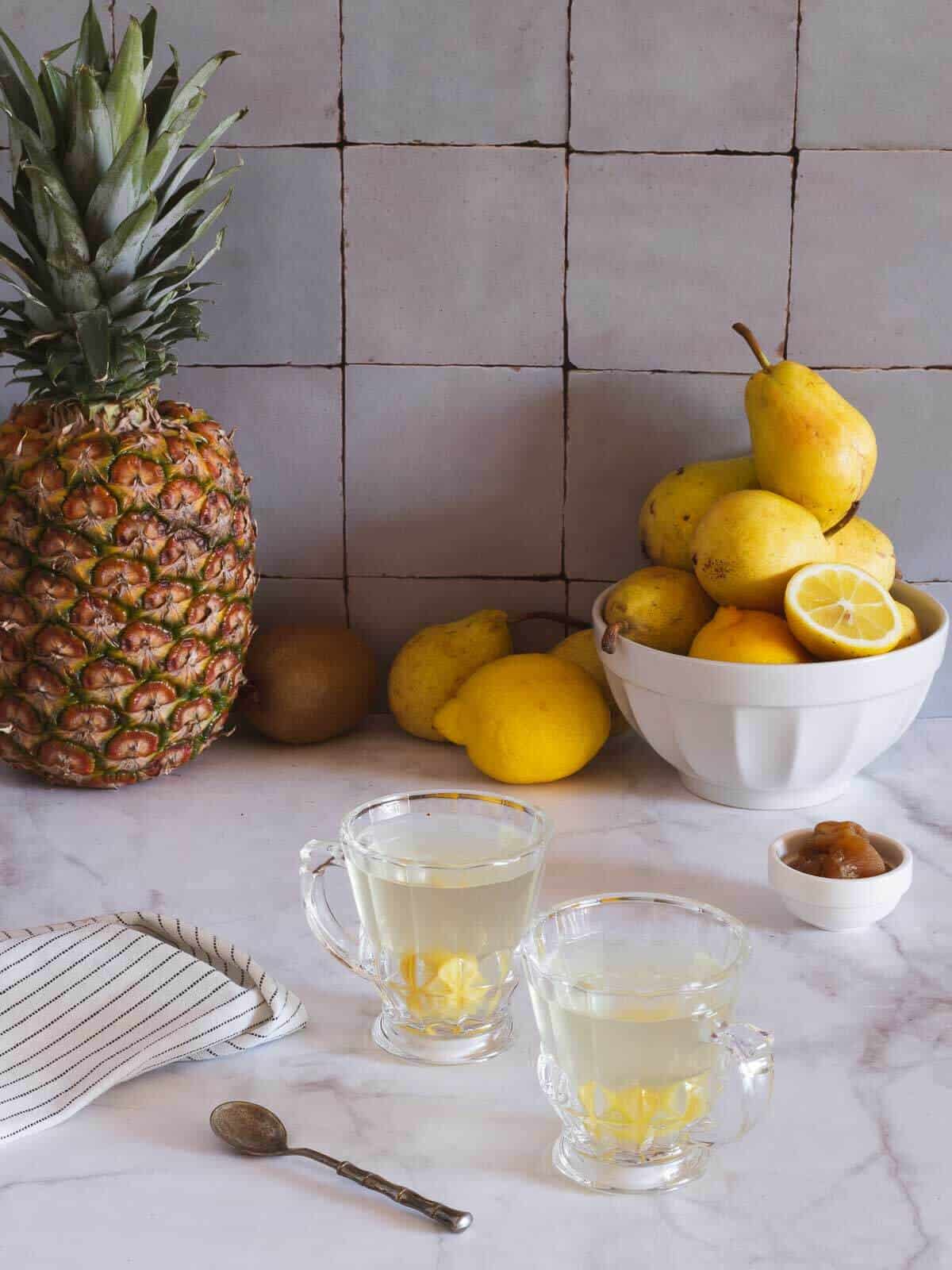
Strain
Straining the fruit-infused water isn't necessary as any particles usually decant to the bottom of the bottle, but if you want to ensure you have 100% clear pineapple water, pass it through a fine-mesh strainer.
Tip: I usually squeeze the soggy pineapple rinds with my hands to extract all the flavor before straining the pineapple water.
Sweeten (optional)
Although I learned to drink pineapple water as a sweet drink as a child, I find it completely unnecessary. Pineapple rinds will infuse some sweetness into the drink, and no added sugar is necessary.
But until just fifteen years ago, I drank tea with sugar, not anymore.
If you want to add some extra sweetness, you can add a tablespoon of date paste, maple syrup, agave nectar, or coconut sugar into the drink. The drink will darken a bit, depending on the sweetener you use.
Reserve
I like bottling the pineapple water in a large jar and enjoying it chilled on warm days. I also like serving this refreshing and hydrating drink in a glass with ice cubes and the remaining boiled pineapple chunks for extra fiber.
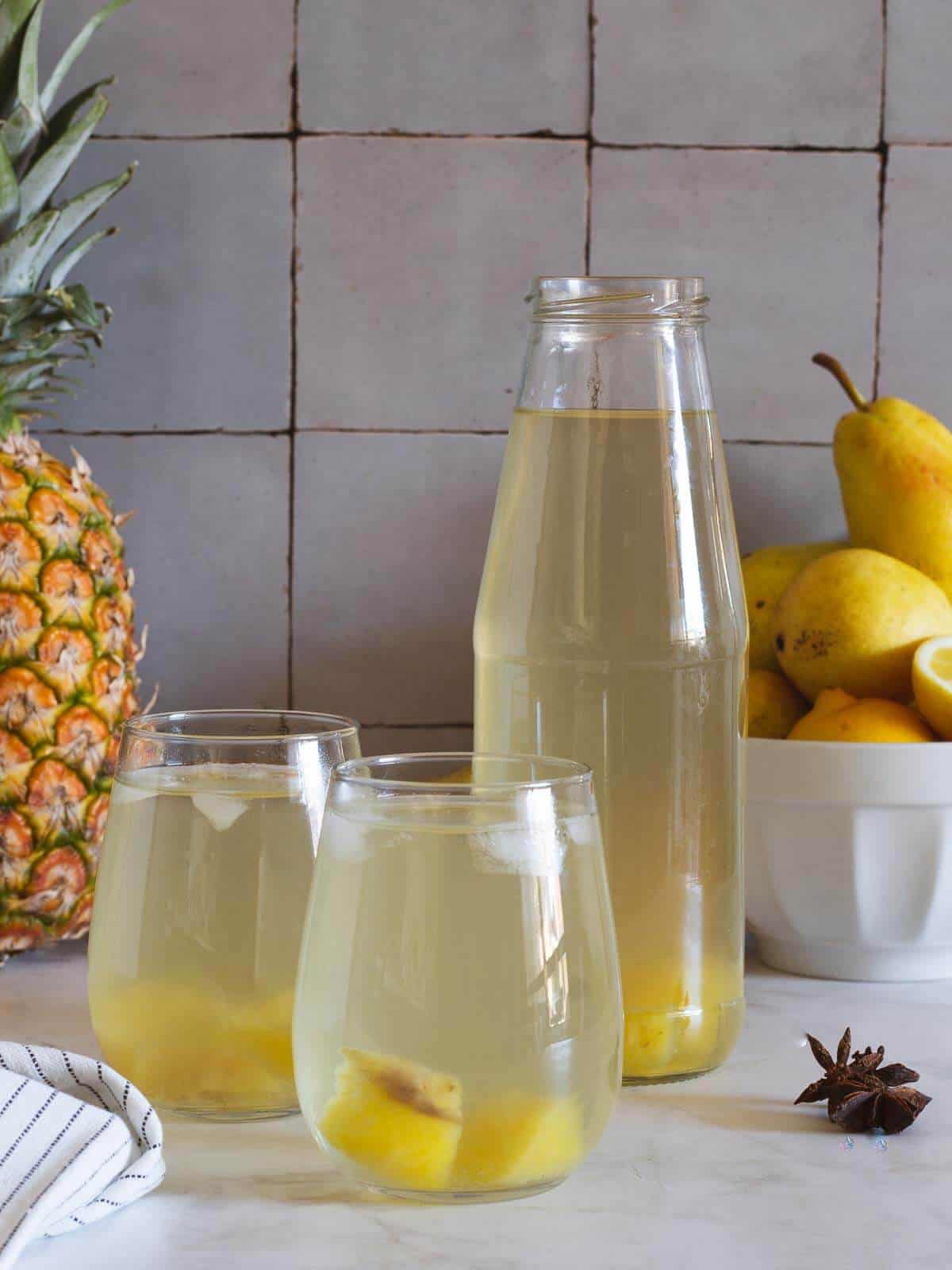
📖 Variations
After savoring the delicate flavors of your pineapple water, take the next step with those pineapple pieces with other kitchen staples.
Grab a pitcher and create a tantalizing infused pineapple ginger cucumber lemon water, a Delicious detox drink
But why stop there? You can elevate this into a third recipe by using the infused produce to whip up pineapple cucumber ginger lemon juice.
This approach is a great way to fully utilize your ingredients, ensuring nothing goes to waste while adding an extra layer of zest to your juice. Each sip is guaranteed to be a refreshing and delightful experience!
Also, this great recipe is easy to modify and adjust, giving it different flavor twists.
Flavor
Add star anise, fresh ginger, cloves, cinnamon sticks, lime, or lemon to the water while it boils. You can also add fresh mint leaves when the fruit-infused water is already chilled, as the leaves darken with heat.
Sweeter
Add your choice of sweeter, like coconut sugar, date paste, maple syrup, agave nectar, stevia leaves, or regular sugar.
Another drink
We make a horchata (rice base drink) called Arroz con Piña, simply adding half a cup of rice to the boiling water. Then remove the rinds and blend in a high-speed blender with cinnamon, vanilla, oat milk, ice cubes, and sweetener.
Add antioxidants
If you feel like adding some extra nutrients, Vitamin C, antioxidant content, and anti-inflammatory benefits to your drink, add a tablespoon of chia seeds and let it infuse overnight.
Add painkilling effect
You can include in the boiling water a tablespoon of fennel seeds. Fennel has been found to help relieve pain. A study from Bangladesh found that fennel extract reduced pain symptoms to a level close to what aspirin does. (source)
If you want are looking for drinks that may help alleviate pain try this juice.
✅ Benefits of drinking pineapple water
Weight loss
By changing the regular sugary drinks in your diet for this zero-calorie drink, you can easily remove a good amount of calories from your daily intake. If you love pineapple and trying to lose weight, this juice may be for you.
You can use a weight loss calculator to estimate how long it might take to reach your weight loss goals and determine the appropriate calorie deficit needed to achieve them. These calculators take into account factors such as your current weight, height, age, gender, activity level, and desired weight loss rate to provide an estimate of how many calories you should consume daily to achieve your goals.
Anti-inflammatory
Inflammation is important in the development of cancer. It helps with the transformation of cells, the growth of tumors, and the spread of cancer to other parts of the body.
Scientists have found that if they can control chronic inflammation, it can help reduce cancer incidence and also slow down cancer progression.
Bromelain in pineapple has been shown to decrease inflammatory mediators and has demonstrated significant anti-inflammatory effects in many different conditions. (source).
Intestinal function
Studies found that pineapple peel could be a promising candidate for human intestinal function and health. (source)
So don’t throw away your pineapple peels, and give this delicious Pineapple Water a try. Not only is it refreshing, but you’ll also get all the health benefits of drinking fresh pineapple juice. Cheers to staying hydrated!
If you like tonics and infusions, you need to try this anti-inflammatory powerhouse, turmeric, and ginger tea that is part of our morning rituals.
Immunity
Pineapple is an excellent source of vitamin C and manganese, both of which are crucial for supporting immune function.
Cut added sugar intake
Creating carbonated pineapple water may help in reducing the intake of added sugar commonly found in most sodas, while still offering the fizzy sensation many enjoy. Fruit-infused sparkling water is a satisfying, low-sugar, and low-calorie alternative to soda that delivers the same gratifying fizz, making it a great substitution for sugary beverages.
❓ FAQ
While drinking pineapple water generally poses no problems for most people, those with certain medical conditions should exercise caution. The acidity of pineapple may cause heartburn or digestive issues for some, and the bromelain it contains may interact with certain medications. It is advisable to consult a doctor or pharmacist if there are any concerns. According to Stefanow, adding fruit infusion to water is a healthier way to enhance flavor than juice, making it difficult to overindulge.
Infused water is an ideal option for those who are not fond of the taste of plain water or anyone who enjoys drinking flavored water.
By combining fruits and herbs in water and letting them infuse for several hours, a delicious and subtly flavored drink can be enjoyed, with the best results obtained after leaving it to infuse overnight.
🍍 More pineapple recipes
And if you like this type of infusion, you will surely love our sorrel drink (made out of hibiscus flowers).
⭐ If you try this pineapple skin water recipe, let us know! 💬 Leave a comment, rate it, and don't forget to tag us @ourplantbasedworld on Instagram. Cheers!
🎥 Video
📋 Recipe
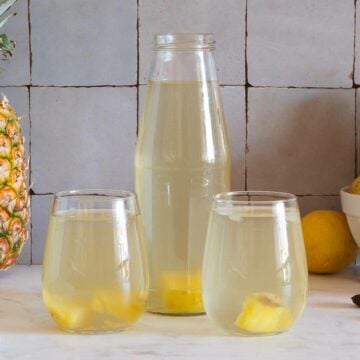
How to Make Pineapple Water
Ingredients
- 1 pineapple Peel of a whole pineapple, you can use frozen pineapple peels.
- ½ gallon water
Optional extra flavoring
- ginger fresh, sliced
- star anise
- stick cinnamon
- cloves
- lemon peel
- fennel seeds to make a hot infusion for pain relief
Directions
- Peel pineapple. If you plan to drink your pineapple water on its own, without any other flavoring or sweetener, leave a little bit of flesh on the rinds so the flavor is more concentrated.
- Boil. Put the pineapple peels in a large saucepan and fill it with water. Let it boil for 15 minutes.
- Cool down. Let the infused pineapple water cool down if planning to drink it as a cold drink. Then transfer it to a bottle and then to the fridge; otherwise you can serve it hot as a cup of tea.
Video
Notes
Nutrition Facts
Nutritional Disclaimer
The information shown is an estimate provided by an online nutrition calculator. It should not be considered a substitute for a professional nutritionist's advice. See our full Nutritional Disclosure here.
Affiliate Disclaimer
Please note that some of the links here are affiliate links, and I will earn a commission if you purchase through those links. I recommend all of the products listed because they are companies I have found helpful and trustworthy.

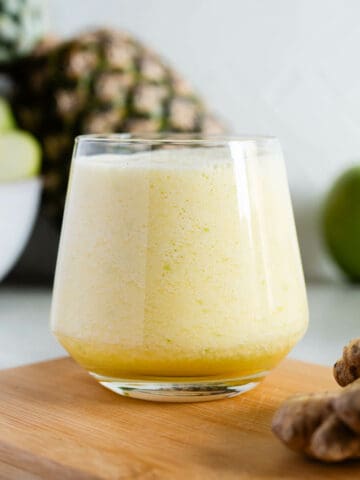
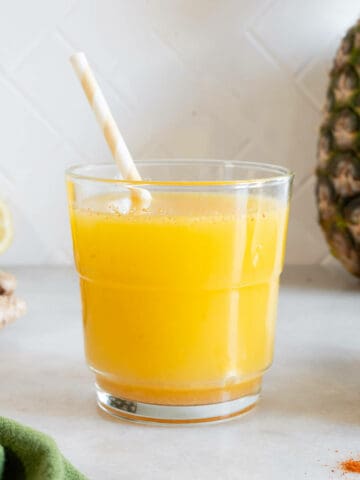
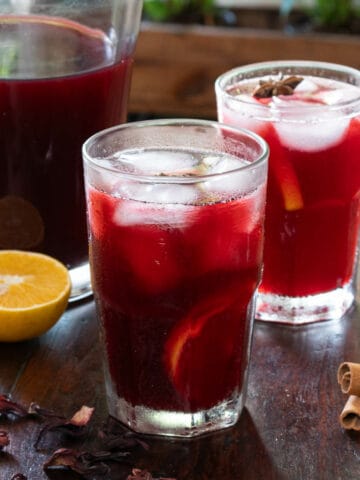
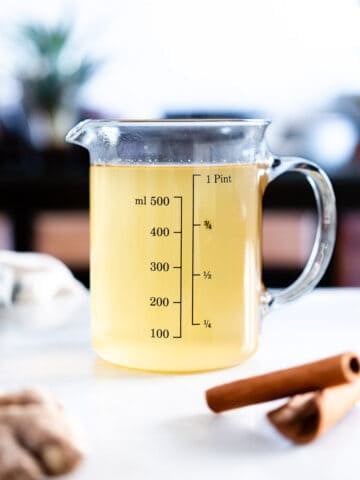


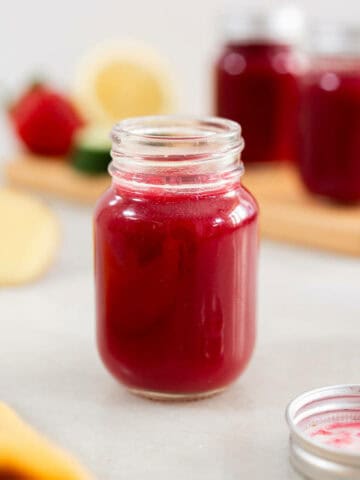
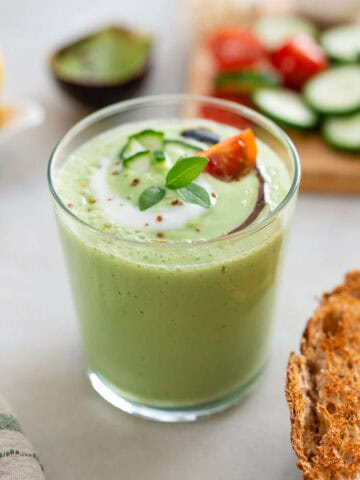
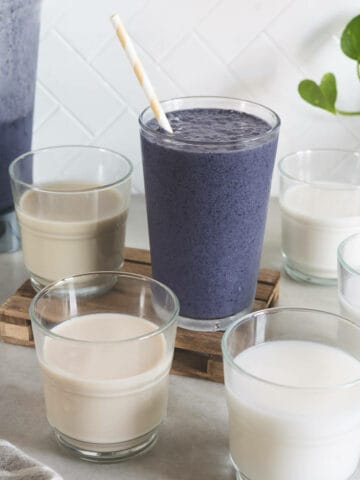
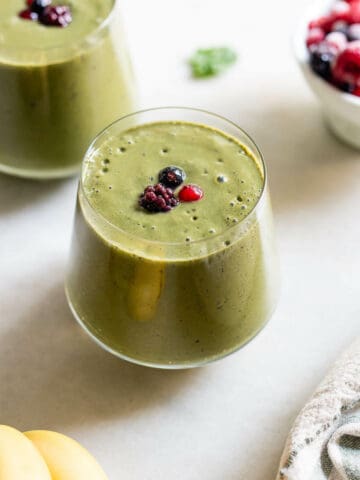
Meme
Hi I have a question regarding using the rind. What about pesticides being on the rind? Or fertilizer? I'm concerned about drinking water tainted with these. How are you combating this? Are u buying organic or something? And doesn't organic mean nothing in the soil? That wouldn't exclude spraying the fruit?
Anyway, hope u can shed some light on this for me.
Gus
Hi Meme, thanks for your question. When it comes to pesticides, our go-to resource is the dirty-dozen guide. We don't buy all organic food because it can be very expensive. We usually buy organic foods from all the fruits and vegetables on this list. Pineapple is not part of it, so we don't usually buy it organic or worry about pesticide content. Also, this recipe requires boiling for a fair amount of time, providing an extra layer of protection. I hope this is helpful!
Diana Lindsey
I’m sure fresh pineapple is best to use, but could you maybe add canned pineapple juice to water to make pineapple water?
Joaco
Hi Diana, you certainly could. We usually make the pineapple water out of the pineapple rinds to make the best out of the whole fruit. When we want it to be even fruitier, we add some pineapple chunks or pineapple's fibrous hearts, which corresponds to using canned pineapple. I would use about one can boil 32 oz of water and make a second batch since you are using fruit instead of rinds. The second time, the pineapple water will be blander. Let us know how it goes! Cheers!
Alexia
What about the core? Can you add that too for more flavor?
Gus
Sure thing! The core will add more flavor, I usually eat it because I like packing fiber, but when we don't eat it, we add it into the boiling water. 🙂
Shelley
Oh my goodness - how have I not heard of this before?? I love that this uses a part of the fruit that would otherwise be discarded. And wow - so many great tips so I get this exactly right and can adjust it to my liking, too (mmmmm ... like maybe adding fresh ginger and cinnamon sticks)!
Gus
Hey, yes, it is a well-kept secret! Probably closer to people in South America, where it is more ubiquitous. I am glad you liked the variation suggestions!
Mirlene
This is a great drink to keep me hydrated. I got tired of drinking lemon water and this is much sweeter than the old lemon water.
Gus
Hey Mirlene, I am glad you liked it! Yes, it is really nice to have some variations to keep ourselves hydrating without being boring. Pinapple-insfused water is definitely at the top of my list.
Jaime McBee
Your recipes are amazing and very helpful in incorporating additional flavors to meet specific purposes. While using pineapple water for years to maintain weight loss and maximum benefits it is found that heating it over 158F degrees will inactivate the bromelain which are the enzymes that you want. Have I misunderstood this heat process over the years? Please advise as if that's the case why not just use canned fruit?
Thank you
-Jaime
Gus De Obaldia
Hey Jaime,
Thanks for diving into our recipes and for bringing up such an excellent point about pineapple water! You're absolutely on the money about the temperature sensitivity of bromelain. Bromelain, the enzyme found in pineapple, does start to break down when exposed to temperatures over 158°F (70°C). You're also correct that this enzyme is one of the main draws for people who want to maximize the health benefits of pineapple water.
So, why not just use canned pineapple, you ask? Well, canned pineapple often undergoes a heat treatment as part of the canning process. This heat treatment not only degrades bromelain but can also reduce other nutrients and alter the flavor profile of the fruit. Fresh pineapple water keeps the bromelain intact and offers a burst of fresh flavor that canned pineapple just can't match.
But here's a tip: If you're cooking with pineapple water and still want to maintain the enzyme's benefits, consider adding it toward the end of the cooking process when the dish is off the heat. That way, you get to enjoy the flavors without compromising on the nutritional punch.
Hope this clears up any confusion! Keep those thoughtful questions coming; they make our day!
Cheers,
Gus
Andrea
I'm trying to drink more water so this is a great recipe to try. I'm wondering what it tastes like with the cinnamon! Sounds delicious!
Kristina
This is a great way to make flavorful homemade water. My kids and I love pineapple, so they loved this recipe. It's so easy and is a great way to avoid buying overly processed and sweetened juices.
Gus
Yep! Completely agree! Kids love it and is 100% natural!